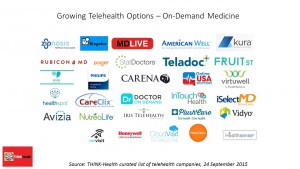 Direct-to-consumer retail health options are fast-growing in the U.S. health ecosystem. CVS Health brought three telemedicine vendors to its pharmacy brick-and-mortar stores. CVS also acquired Target’s pharmacies, expanding its retail health footprint. Rite Aid has added HealthSpot kiosks to its pharmacies, while Walgreens expanded its relationship with MDLive. And, Cox Cable acquired Trapollo to bring remote health monitoring into subscribers’ homes, along with the cable company’s venture with Cleveland Clinic, Vivre Health.
Direct-to-consumer retail health options are fast-growing in the U.S. health ecosystem. CVS Health brought three telemedicine vendors to its pharmacy brick-and-mortar stores. CVS also acquired Target’s pharmacies, expanding its retail health footprint. Rite Aid has added HealthSpot kiosks to its pharmacies, while Walgreens expanded its relationship with MDLive. And, Cox Cable acquired Trapollo to bring remote health monitoring into subscribers’ homes, along with the cable company’s venture with Cleveland Clinic, Vivre Health.
Coupled with the growing supply side of telemedicine vendors, the latest National Business Group on Health survey found that most large employers plan to expand the telemedicine services they offer. Three in four large employers (74%) plan to offer telemedicine to workers in 2016, a dramatic increase from 48% in 2015. This trend is part of business’ continued challenge of bending corporate cost curves for health and designing the health benefit to deliver lower-cost, convenient on-ramps to health care for employees looking for lower-cost services paid out by their own high-deductible health plans.
As telemedicine mainstreams to Main Street, what does the growth of retail health, enabled through technology, mean for health care providers?
Read the implications in my iHealthBeat column, here, published 23rd September 2015.
Health Populi’s Hot Points: “US Behind the World in Telemedicine,” argues an article in the 17 September 2015 Hospitalist journal. The column quotes Dr. David Asch of The University of Pennsylvania Center for Health Care Innovation, who said in an email, “I think it is a trap to think that the only promise of telemedicine is the opportunity to do something remotely that used to happen face to face. The real opportunities will come from doing health care in a different way because of this remote technology.”
I emphasize this vision because Dr. Asch hits on the transformational opportunity that telehealth brings: doing health and healthcare in new ways, new workflows, sharing decision making and care with patients and extended care teams, and re-imagining the patient’s home as her practical medical home.
The U.S. is indeed behind other nations, like Canada and the United Kingdom, in telehealth adoption mainstreaming through primary and specialty care. But America is also a laggard compared with many developing nations’ health systems. So much for spending more on health care than any country in the world, both in macro national health expenditure and per capita terms.
Paying for outcomes, bundles, quality, and performance, and bolstering — re-inventing — our primary care backbone will be the two factors that will continue to drive telehealth adoption in the U.S.




 Thank you FeedSpot for
Thank you FeedSpot for